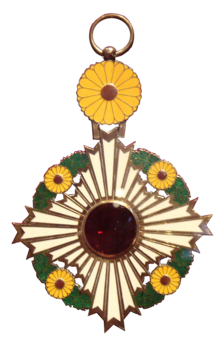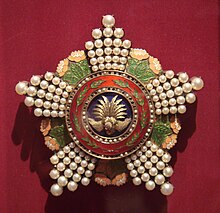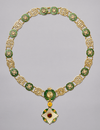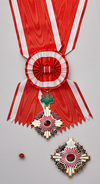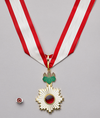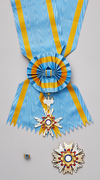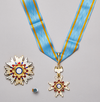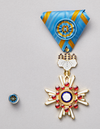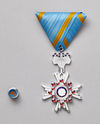
The prime minister of Japan is the head of government and the highest political position of Japan. The prime minister chairs the Cabinet of Japan and has the ability to select and dismiss its ministers of state. The prime minister also serves as the commander-in-chief of the Japan Self Defence Forces and is a sitting member of either house of the National Diet. The current prime minister is Fumio Kishida of the Liberal Democratic Party, who assumed the office on 4 October 2021.

Senjūrō Hayashi was a Japanese politician and general. He served as Imperial Japanese Army Commander of the Japanese Korean Army during the Mukden Incident and the invasion of Manchuria. He briefly served as prime minister of Japan in 1937.

The Order of Leopold is one of the three current Belgian national honorary orders of knighthood. It is the oldest and highest order of Belgium and is named in honour of its founder, King Leopold I. It consists of a military, a maritime and a civil division. The maritime division is only awarded to personnel of the merchant navy, and the military division to military personnel. The decoration was established on 11 July 1832 and is awarded by Royal decree.

The Order of Orange-Nassau is a civil and military Dutch order of chivalry founded on 4 April 1892 by the queen regent, Emma of the Netherlands.
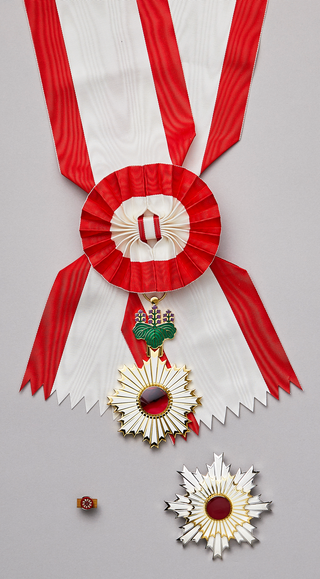
The Order of the Rising Sun is a Japanese order, established in 1875 by Emperor Meiji. The Order was the first national decoration awarded by the Japanese government, created on 10 April 1875 by decree of the Council of State. The badge features rays of sunlight from the rising sun. The design of the Rising Sun symbolizes energy as powerful as the rising sun in parallel with the "rising sun" concept of Japan.

The Order of the Sacred Treasure is a Japanese order, established on 4 January 1888 by Emperor Meiji as the Order of Meiji. Originally awarded in eight classes, since 2003 it has been awarded in six classes, the lowest two medals being abolished that year. Originally a male-only decoration, the order has been made available to women since 1919.

The Order of Culture is a Japanese order, established on February 11, 1937. The order has one class only, and may be awarded to men and women for contributions to Japan's art, literature, science, technology, or anything related to culture in general; recipients of the order also receive an annuity for life. The order is conferred by the Emperor of Japan in person on Culture Day each year. It is considered equivalent to the highest rank of the Order of the Rising Sun, the Order of the Sacred Treasure, and the Order of the Precious Crown. The only orders that Japanese emperors bestow on recipients by their own hands are the Collar of the Supreme Order of the Chrysanthemum, the Grand Cordon of each order, and the Order of Culture.
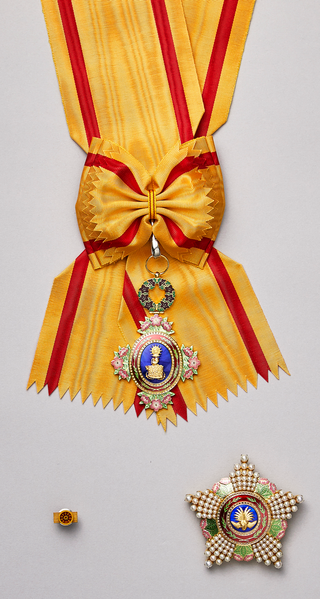
The Order of the Precious Crown is a Japanese order, established on January 4, 1888 by Emperor Meiji of Japan. Since the Order of the Rising Sun at that time was an Order for men, it was established as an Order for women. Originally the order had five classes, but on April 13, 1896 the sixth, seventh and eighth classes were added.
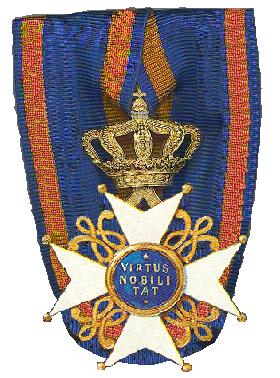
The Order of the Lion of the Netherlands, also known as the Order of the Netherlands Lion is a Dutch order of chivalry founded by King Willem I of the Netherlands on 29 September 1815.

Medals of Honor are medals awarded by the Emperor of Japan. They are awarded to individuals who have done meritorious deeds and also to those who have achieved excellence in their field of work. The Medals of Honor were established on December 7, 1881, and were first awarded the following year. Several expansions and amendments have been made since then. The medal design for all six types is the same, bearing the stylized characters 褒章 on a gilt central disc surrounded by a silver ring of cherry blossoms on the obverse; only the colors of the ribbon differ.
Order of Beneficience is the name given to two different orders in Greece. One of them is conferred by the Greek royal family, and the other is conferred by the Greek government.

Fumio Gotō ) was a Japanese politician and bureaucrat, and briefly served as interim Prime Minister of Japan in 1936.

The Order of the Paulownia Flowers is an order presented by the Japanese government. The award was established in 1888 during the Meiji Restoration as the highest award in the Order of the Rising Sun and has been an Order in its own right since 2003. The only grade of the order is Grand Cordon of the Order of the Paulownia Flowers, which ranks higher than the Order of the Rising Sun, the Order of the Sacred Treasure, the Order of the Precious Crown, and the Order of Culture and lower than the Order of the Chrysanthemum.
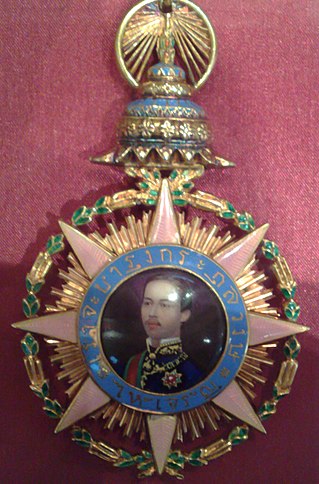
The Most Illustrious Order of Chula Chom Klao was established on 16 November 1873 by King Rama V of The Kingdom of Siam to commemorate the 90th Jubilee of the Chakri Dynasty and bears his name. The pink colour reflects the Tuesday birthday colour for King Rama V.

The Order of the Seal of Solomon is an order of knighthood of the Ethiopian Empire, founded by Emperor Yohannes IV in 1874 as the highest imperial honour, containing five grades. In 1930, an even higher Order was established, i.e. the Order of Solomon, which was a split off from the Order of the Seal of Solomon. The Order was conferred on members of imperial house and upon persons who had rendered meritorious services.
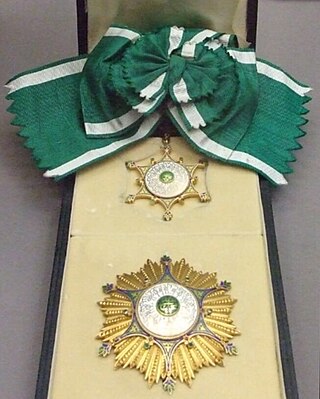
The Royal Order of Muhammad Ali was an order of chivalry and state honour in the Kingdom of Egypt.
Eiichi Nishimura was a Japanese politician, who served in the Ikeda, Satō, Tanaka and Fukuda cabinets, and was the first to be appointed to the post of Director of the National Land Agency. Within the Liberal Democratic Party (LDP), he held influence in the Satō and Tanaka factions, becoming known as the "king's counselor", or the one able to speak his mind with ease.
Tomio Fukuoka (福岡富雄) is a Japanese educator and Academian. He is the Founder/Chairman of Kobe Denshi and Graduate School of Information Technology (KIC).

